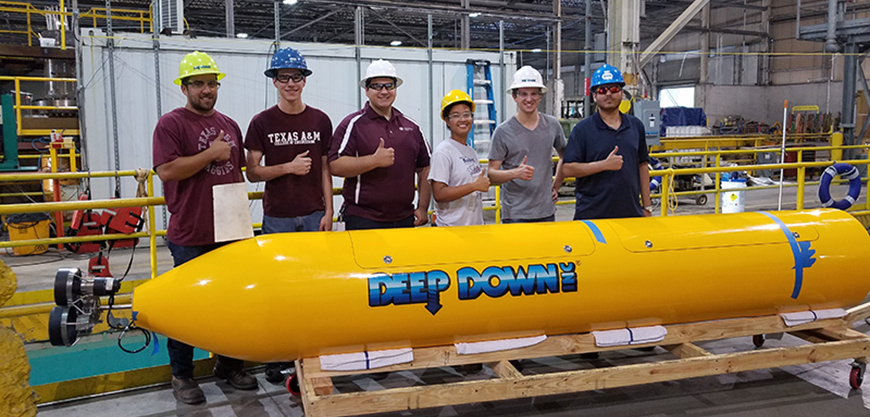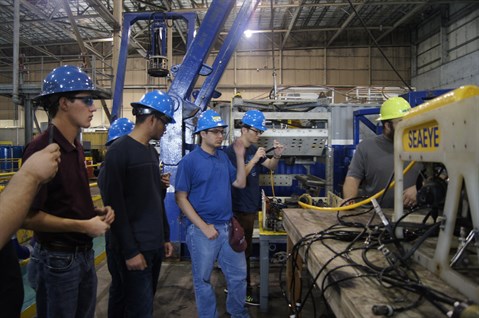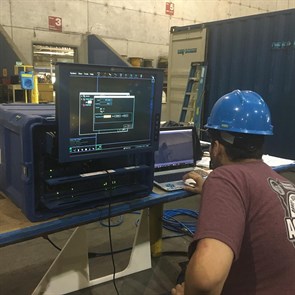
Many students partake in summer internships, study abroad trips or various other experiential learning opportunities offered by the Texas A&M University College of Engineering. An interdisciplinary team of students have combined nearly all of the categories of opportunities into one experience: conquering the Shell Ocean Discover XPrize Challenge.
In just 36 months the challenge was announced, teams created, projects crafted and finalists selected. The student team, Aggie Ocean Discovery, is one of 21 teams headed to the semi final competition in September. Their task: map the ocean floor.

Sophia Esteban is one of the most recent members to have joined the XPrize team after she heard Dr. Sharath Girimaji, ocean engineering department head and holder of the Wofford Cain Chair II, speak of the daunting task the team was attempting to conquer. Now she serves as the payload assembly lead for the team.
“This summer I have learned that it is important to put yourself out there,” said Esteban, a sophomore engineering student. “At first, I hesitated to apply for the team because I thought a team working on a $7 million competition would not want a freshman with absolutely no skills to join. I applied despite this and I am so glad I did. If I hadn’t, I never would have gotten this experience of a lifetime.”
Esteban, along with five other students, moved to Houston, Texas, to become interns with Deep Down Inc. The company is a major sponsor of the team of students who have decided to take on and conquer the proposed XPrize challenge. Teams of industry leaders and company groups from around the world are participating in the quest to design and successfully operate an automated underwater vehicle (AUV) that will fully explore and map the ocean floor, and uncover the planet’s greatest wonder and resource for the benefit of humanity.
“This project has shown me an insight to what my future holds and I’m liking the view. The things I’m learning surprise me every day and I believe this experience is a huge step forward in the right direction for me,” Esteban said. “Ocean engineering hooked me.”
The six students work with, and are mentored by, engineers at Deep Down, Inc. to effectively design and create the AUV Marlin to perform capabilities outlined by the competition. These capabilities include producing a high-resolution bathymetric map, images of a specified object, and identifying archeological, biological or geological features of an area, all within a limited number of hours.
They also have an opportunity to compete for a $1 million bonus prize sponsored by the National Oceanic and Atmospheric Administration requiring the technology track a biological or chemical signal to its source.
“I’ve always wanted to be the one to map the bottom of the ocean and create some kind of Google ocean view like Google maps, so when I heard there was already a team at the school I was in, doing exactly what I want to do, I had to jump on it as soon as I could,” Esteban said. “Even if it meant I would just go to every meeting and simply listen, I just had to be a part of it.”
Dylan Blakeslee, a senior ocean engineering student, expressed interest in the competition after seeing a YouTube video and pitching the idea to Girimaji and his professors. He now serves as the project manager of the Aggie Ocean Discovery Team. This summer Blakeslee is continuing to build upon the relationships he has developed with companies from around the world.
“I meet with executives, directors and project managers to discuss our long-term vision for the project and share our passion for improving the world,” Blakeslee said. “We have been fortunate enough to form intimate relationships with major firms around the world that have played an intricate role in designing and manufacturing our vehicle.”
 Nabil Moosajee, a senior computer science and engineering student, was one of the first people to join the team in March 2016. He serves as the hardware lead and is responsible for selecting the best system components and making them perform as expected. Additionally, he works with the software and microcontroller of the AUV. This role is vital because it is the brain of Marlin and serves as the central command center for all processes on the vehicle.
Nabil Moosajee, a senior computer science and engineering student, was one of the first people to join the team in March 2016. He serves as the hardware lead and is responsible for selecting the best system components and making them perform as expected. Additionally, he works with the software and microcontroller of the AUV. This role is vital because it is the brain of Marlin and serves as the central command center for all processes on the vehicle.
“There is a very big learning curve for almost all of the components we are using, so I work with the engineers of Deep Down Inc. who have been very helpful providing training,” Moosajee said. “Because of their training, a month long learning curve becomes a week or less.”
Lance Lane, a junior ocean engineering student, transferred to Texas A&M in spring 2017. The team’s efforts quickly piqued his interest and he is now working as the propulsion team lead. This experience will solidify the concepts covered by his professors in class by applying the knowledge in a real-world setting.
“This summer, I have learned to work efficiently and the importance of how you carry yourself in all situations, from mingling with CEOs to getting down and dirty with the technicians on the shop floor,” Lane said. “Exploring the ocean is my dream and I want to go into the AUV/ROV industry when I graduate, so making some contacts now and building this AUV with our own hands has given me a huge advantage over other applicants when I graduate and begin applying for jobs.”
Garrett Malatek, a sophomore mechanical engineering student, works as a member of the structures and propulsion design teams. His daily activities range from designing and manufacturing systems for Marlin, to meeting with subsea vendors and even CEOs.
“Seeing system designs that I have worked on for months come together and work as intended is extremely satisfying,” Malatek said. “I am exceptionally proud of this team and what we have accomplished thus far and look forward to continuing to improve the vehicle as we progress in the competition.”
Malatek has witnessed the team make great strides in the process of building the necessary technologies since he joined nearly a year ago. The scope and complexity of the challenge initially drew him to the team, coupled with the technical complexity of mapping the ocean floor, which piqued his interest.
“Having the opportunity to work on a project of this scale and complexity has certainly made me a better engineer,” Malatek said. “It has given me the chance to apply everything I have learned in class to the real world while also teaching me many new skills. As a result of this project and team, I have an ongoing interest in the subsea robotics industry and could absolutely see myself starting a career in the field.”
Little did Blakeslee know what would come of his idea to participate in the Shell Ocean Discover XPrize Challenge. The team is now comprised of more than 30 students from 12 departments in the College of Engineering. They are the sole student team competing in the semifinalist round of competition.
“The students who come into this project and manage to stay with it will leave college capable of working anywhere they want and doing anything they want,” Blakeslee said. “This is the world’s most difficult project, and those who accept the challenge will be able to reap the benefits.”